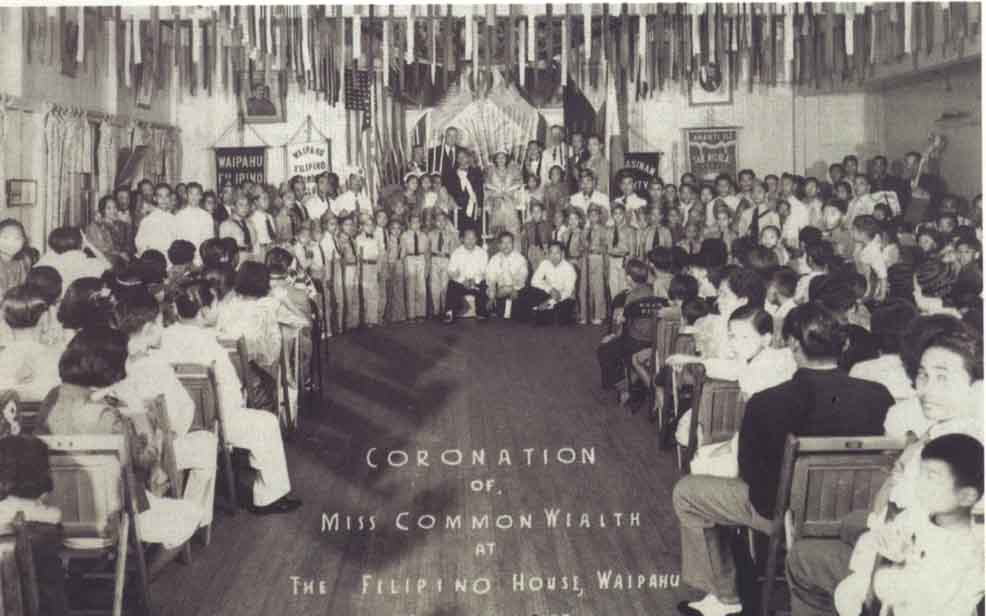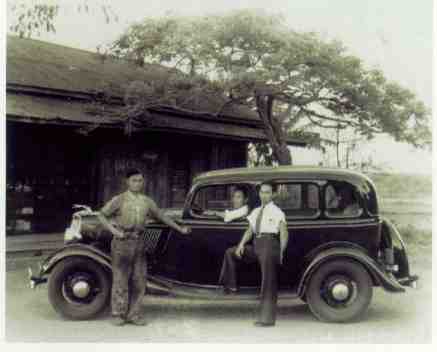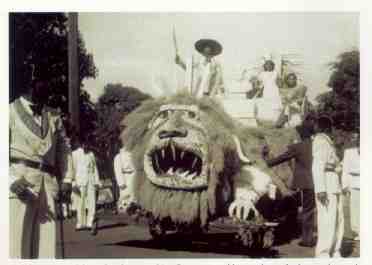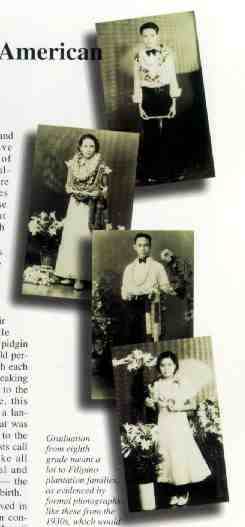>
PLANTATION LEGACY IN HAWAII
FILIPINO-AMERICAN CULTURE IN HAWAII
by Helen R Nagtalon-Miller..Reproduced from
the Winter 1996-1997 issue of AMPERSAND
Pagdiriwang. To most American- an exotic,
unfamiliar word. To the people of the Philippines, a celebration, a festival.
To the Filipino-American community in Hawaii, in 1996--triple commemoration:
the 100th anniversary of the Philippine Revolution, the 90 anniversary
of the first arrival of Filipino contract laborers (sakadas) in Hawaii,
and the 50 anniversary of the arrival of the last wave of Filipino plantation
workers.
Pagdiriwang 1996 has been celebrated
across Hawaii and throughout the year ending with film and arts presentations,
a traveling photo exhibit, exhibitions for works by Filipino-American artists,
community forums and other programs. Woven into the commemoration have
been two recurring themes- the history and identity of Hawaii's Filipino
Community. Both are closely linked with the memory of life on Hawaii's
sugar and pineapple plantations- the fertile soil in which so many people
spent their formative years, and often, their whole lives.
The concerns of Filipino youth in Hawaii during
the years for my childhood and adolescence in the 1930s and 1940s revolved
mainly around the question of group identity: getting along with people
of all ethnicities, respecting the cultural values of one's parents, reconciling
those values taught with American cultural values taught in school, and
dealing with the ethnic and cultural slurs and stereotypes- blatant and
subtle- that quarreling children and adults of all ethnic groups hurled
at each other.
Like earlier immigrant groups, Filipinos
came to Hawaii to improve their lives. They struggled, fought for better
wages and working conditions, used their culture's coping skills, and continually
strove for dignity and abetter life. If we look at what plantation life
was like, we will see that today's Hawaii is a legacy of the early plantation
days where the good will and aloha spirit of the Native Hawaiians influenced
all of Hawaii's many immigrant cultures. Filipino-American cultures in
Hawaii today amalgamates influences from many of these cultures with the
cultures that Filipino migrants brought with them to Hawaii.
Intermingling of cultures was mirrored
in the very language used on the plantations. Since the Native Hawaiians,
and the Chinese, Filipino, Japanese, Korean, Portuguese, and Puerto Rican
immigrants all spoke their own languages and knew little English, it was
inevitable that a pidgin would come into being that would permit laborers
to communicate with each other as well as with English-speaking supervisors.
This was essential to the newcomers' survival. In time, this make-shift
patois evolved into a language with its own structure that was passed on
from one generation to the next. I had become what linguists call a Hawaii
English Creole. Like all other languages, it was a vital and inseparable
part of the culture- the plantation culture- that gave it birth.
When the first Filipinos arrived in Hawaii
in 1906, they too began contributing to the development of Hawaii English
Creole, introducing Filipino words. It is not surprising then, that the
ethnically mixed plantation work crew that eradicated weeds was called
"sabidong (Ilokano for poison") gang," or that the Filipino grammatical
pattern of beginning as sentence with a verb ("go already the boss") was
accepted in Hawaii Creole English. Today "Pidgin," as people in Hawaii
call the local idiom, is a language that children have to learn- alongside
the "Standard English" taught in the class room-in order to get along with
their classmates.
Plantation life enforced early generations
of Filipinos a variety of experience in common. We lived in houses provided
at no cost by the plantation. Our homes were organized in camps that were
segregated from other ethnic groups. We bought most of our food and clothing
from the plantation stores and, if our families were short of cash, credit
would be provided. Some children were born at home, but most of us were
born in and treated for our illnesses at the plantation hospital. We were
entertained at the Filipino Club House, a recreational building provided
by the plantation. Our young people, especially the males, enjoyed the
ballparks provided-again- by the plantations. In the case of the minority
of us who were Protestants, we worshiped in church building provided by
plantation management for the large groups who worshiped and conducted
religious instruction in the language of their members. The great majority
of Filipinos worshiped in the multi-ethnic Catholic churches where the
liturgy was (in those days) still in Latin.
While the public schools in the rural
areas of Hawaii were not under direct control of plantation management,
they were looked upon as an extension of the plantation because virtually
every child had parents who worked on the plantation. School principal
and teachers were often included in the social milieu of the plantations
hierarchy, and school program tended to represent middle-class American
values of hard work and upward mobility, which have motivated second generation
Filipino-Americans from the early 1930s to the present. Although Filipino
immigrants did not own their own homes or lots (everything was owned by
the plantations, which provided for most of their needs), our families
were largely content with this economic support system. I any case, for
most people there was no alternative. Most laborers had little or no schooling.
We lived in groups where language and cultural values were shared. While
wages were meager, women took in laundry, made and sold ethnic foods, and
did sewing to supplement their husbands' pay, and many people were able
to send money regularly to parents, siblings, or wives and children who
remained in the Philippines, enabling them to buy property or finance an
education.
In those days before television and shopping
malls, our lives centered around work, school, church, playgrounds and,
when there were no cockfights to attract the single men, the plantation
social halls.
The Filipinos and Japanese on the plantation
where I grew up (the Oahu Sugar Company) both had their own social halls.
For us it was called the Filipino Club House, a large frame building in
the same plantation style that is now depicted at the Waipahu Cultural
Garden Parks' Plantation Village Museum. Attached to our club house was
a pool hall with a cigarette and candy counter, a kitchen where small plantation-provided
staff prepared meals (my father worked there for a time under the supervision
of his future father-in-law, my maternal grandfather), a dining hall, and
a large social hall for programs and dances.
The kitchen served some of the day-to-day
needs for the single men, but it was the weekend activities at the Filipino
Club House that were most important, especially the "box socials." Most
of the relatively few single young Filpinas would attend, bringing with
them a gift box meal to be raffled or auctioned off to interested single
men. The winner would then be able to share the meal with the young woman
and, perhaps, even have the first and last dance with her.
.
 Important
events in Philippine history were often celebrated in the club house. Jose
Rizal, the foremost martyr of the Philippine Revolution against the Spanish,
was remembered each year on December 30, the anniversary of his execution
in 1896. In some years there were special programs to mark his birth as
well. After 1936, when the US granted the Philippine commonwealth status
and promised the independence for which Filipinos had fought and Rizal
and many others had died, Commonwealth Day was celebrated annually in the
club house or at the nearby ball park.
Important
events in Philippine history were often celebrated in the club house. Jose
Rizal, the foremost martyr of the Philippine Revolution against the Spanish,
was remembered each year on December 30, the anniversary of his execution
in 1896. In some years there were special programs to mark his birth as
well. After 1936, when the US granted the Philippine commonwealth status
and promised the independence for which Filipinos had fought and Rizal
and many others had died, Commonwealth Day was celebrated annually in the
club house or at the nearby ball park.
Filipino community groups as well as
families or individuals would use the social hall's facilities. The Waipahu
Filipino Women's Club met there as did the Legionarios del Trabajo, a sort
of Filipino Masonic Lodge.
World War II brought major changes to Hawaii's
plantation communities. The great increase in military presence in the
islands created a demand services that the pre-war civilian economy was
unable to meet. Martial law authorities and plantation management both
imposed sanctions in an effort to keep workers from leaving their jobs
and reducing production in the field and mills. The military governor issued
an edict that made it a crime to leave a plantation job without permission,
and the plantations told their workers that those who quit their jobs would
not be rehired after the war.
Nonetheless, many workers did leave the
plantation for higher-paying service jobs on military bases and in surrounding
communities. The sanctions threatened by the authorities were rarely invoked
because of the clear need to provide services for hundreds of thousands
of military personnel. The plantations' sanctions could not be invoked
until the war was over.
.
 At the end
of the war in August 1945, efforts were made to return to the pre-war status
quo. Plantations generally refused to rehire workers who had left for higher-paying
jobs on and around military facilities. Thus was created a new groups of
Filipino men who were called "bulakbul." The word, a Filipino "adaptation"
of an English work (and used as noun, adjective and verb alike), was first
used in the Philippines in the early years of the century for those Filipinos
who took part in the American phase of the Philippine Revolution (known
in American textbook as the Filipino Insurrection). These Filipino soldiers
were banned from all employment-"blackballed." Just as in the Philippines
in the early years of the century, there were many bulakbul in Hawaii's
plantation communities after World War II. They generally relied on friends
and relative for support and took short term jobs where they could find
them. However the circumstances were such that, through no fault of their
own, they appeared to be shiftless; so to many bulakbul took on the meaning
"lazy."
At the end
of the war in August 1945, efforts were made to return to the pre-war status
quo. Plantations generally refused to rehire workers who had left for higher-paying
jobs on and around military facilities. Thus was created a new groups of
Filipino men who were called "bulakbul." The word, a Filipino "adaptation"
of an English work (and used as noun, adjective and verb alike), was first
used in the Philippines in the early years of the century for those Filipinos
who took part in the American phase of the Philippine Revolution (known
in American textbook as the Filipino Insurrection). These Filipino soldiers
were banned from all employment-"blackballed." Just as in the Philippines
in the early years of the century, there were many bulakbul in Hawaii's
plantation communities after World War II. They generally relied on friends
and relative for support and took short term jobs where they could find
them. However the circumstances were such that, through no fault of their
own, they appeared to be shiftless; so to many bulakbul took on the meaning
"lazy."
Other changes followed. Because of impending
Philippine independence in July 1946 and tight US immigration laws that
would treat Filipinos as foreigners once independence was achieved, the
last group of contract laborers, the 1946 sakadas, was recruited. The ILWU
organized sugar and pineapple workers into a multi-ethnic union and began
a series of strikes- in which the 1946 sakadas too, though only newly arrived,
played a role- that culminated in the unionization of the plantation and
the beginning of the end of the old paternalistic system.
 Other big
changes were in store for Hawaii's Filipino Community. The Immigrations
Act of 1965 made possible the unification of families.: thousands of relative
of Filipinos already in Hawaii began to arrive. Other provisions of the
Act allowed professionnals to settle in the United states: new immigrants
from the Philippines had a far higher level of education thant the sakadas
who proceded them. Meanwhile, larger economic and political developments
saw tourism eclipse agriculture as the dominant force in the Hawaii economy.
Sugar and pineapple shrank not only relatively but absolutely, and many
plantation workers moved inot other occupations.
Other big
changes were in store for Hawaii's Filipino Community. The Immigrations
Act of 1965 made possible the unification of families.: thousands of relative
of Filipinos already in Hawaii began to arrive. Other provisions of the
Act allowed professionnals to settle in the United states: new immigrants
from the Philippines had a far higher level of education thant the sakadas
who proceded them. Meanwhile, larger economic and political developments
saw tourism eclipse agriculture as the dominant force in the Hawaii economy.
Sugar and pineapple shrank not only relatively but absolutely, and many
plantation workers moved inot other occupations.
The old plantation system is gone now. Yet
its influence lives on among all those who still carry with them memories
of a time and place where everyone shared what they had, helped each other,
and were concerned about the well-being of the group. And thought the number
of people who carry such memories is slowly dwindling, there is much in
the culture-even the language- of newer generations that is a legacy of
that earlier time.
For the Filipinos in Hawaii, it is an element
of our culture worth remembering, and celebrating. A reason for PAGDIRIWANG.
Reproduced from the Winter 1996-1997 issue
of AMPERSAND, a publication of Alexander & Baldwin, Inc @Alexander
& Baldwin, Inc. (Any inquiries or requests for permission to reprint
should be addressed to Howard E Daniel, Publication Manager, Alexander
& Baldwin, Inc., PO Box 3440, Honolulu, HI 96801-3440; tel 808-525-8439;
FAX:808-525-6677.)
Helen
R Nagtalon-Miller, Ph.D., is president of the Filipino-American Historical
Society of Hawaii. A retired faculty member and administrator at the University
of Hawaii, she grew up in a plantation camp in Waipahu, on the island of
Oahu.
 --------------------------------------------------------
Read my other oldtimer from Hawaii--
--------------------------------------------------------
Read my other oldtimer from Hawaii--
Elario Questas, 112 years
Aug 6, 1886-Feb 20, 1999
 Important
events in Philippine history were often celebrated in the club house. Jose
Rizal, the foremost martyr of the Philippine Revolution against the Spanish,
was remembered each year on December 30, the anniversary of his execution
in 1896. In some years there were special programs to mark his birth as
well. After 1936, when the US granted the Philippine commonwealth status
and promised the independence for which Filipinos had fought and Rizal
and many others had died, Commonwealth Day was celebrated annually in the
club house or at the nearby ball park.
Important
events in Philippine history were often celebrated in the club house. Jose
Rizal, the foremost martyr of the Philippine Revolution against the Spanish,
was remembered each year on December 30, the anniversary of his execution
in 1896. In some years there were special programs to mark his birth as
well. After 1936, when the US granted the Philippine commonwealth status
and promised the independence for which Filipinos had fought and Rizal
and many others had died, Commonwealth Day was celebrated annually in the
club house or at the nearby ball park.
 At the end
of the war in August 1945, efforts were made to return to the pre-war status
quo. Plantations generally refused to rehire workers who had left for higher-paying
jobs on and around military facilities. Thus was created a new groups of
Filipino men who were called "bulakbul." The word, a Filipino "adaptation"
of an English work (and used as noun, adjective and verb alike), was first
used in the Philippines in the early years of the century for those Filipinos
who took part in the American phase of the Philippine Revolution (known
in American textbook as the Filipino Insurrection). These Filipino soldiers
were banned from all employment-"blackballed." Just as in the Philippines
in the early years of the century, there were many bulakbul in Hawaii's
plantation communities after World War II. They generally relied on friends
and relative for support and took short term jobs where they could find
them. However the circumstances were such that, through no fault of their
own, they appeared to be shiftless; so to many bulakbul took on the meaning
"lazy."
At the end
of the war in August 1945, efforts were made to return to the pre-war status
quo. Plantations generally refused to rehire workers who had left for higher-paying
jobs on and around military facilities. Thus was created a new groups of
Filipino men who were called "bulakbul." The word, a Filipino "adaptation"
of an English work (and used as noun, adjective and verb alike), was first
used in the Philippines in the early years of the century for those Filipinos
who took part in the American phase of the Philippine Revolution (known
in American textbook as the Filipino Insurrection). These Filipino soldiers
were banned from all employment-"blackballed." Just as in the Philippines
in the early years of the century, there were many bulakbul in Hawaii's
plantation communities after World War II. They generally relied on friends
and relative for support and took short term jobs where they could find
them. However the circumstances were such that, through no fault of their
own, they appeared to be shiftless; so to many bulakbul took on the meaning
"lazy."
 Other big
changes were in store for Hawaii's Filipino Community. The Immigrations
Act of 1965 made possible the unification of families.: thousands of relative
of Filipinos already in Hawaii began to arrive. Other provisions of the
Act allowed professionnals to settle in the United states: new immigrants
from the Philippines had a far higher level of education thant the sakadas
who proceded them. Meanwhile, larger economic and political developments
saw tourism eclipse agriculture as the dominant force in the Hawaii economy.
Sugar and pineapple shrank not only relatively but absolutely, and many
plantation workers moved inot other occupations.
Other big
changes were in store for Hawaii's Filipino Community. The Immigrations
Act of 1965 made possible the unification of families.: thousands of relative
of Filipinos already in Hawaii began to arrive. Other provisions of the
Act allowed professionnals to settle in the United states: new immigrants
from the Philippines had a far higher level of education thant the sakadas
who proceded them. Meanwhile, larger economic and political developments
saw tourism eclipse agriculture as the dominant force in the Hawaii economy.
Sugar and pineapple shrank not only relatively but absolutely, and many
plantation workers moved inot other occupations.
 --------------------------------------------------------
Read my other oldtimer from Hawaii--
--------------------------------------------------------
Read my other oldtimer from Hawaii--